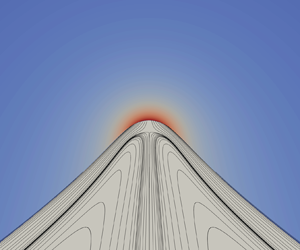Crossref Citations
This article has been cited by the following publications. This list is generated based on data provided by
Crossref.
Petro, Elaine M.
Gallud, Ximo
Hampl, Sebastian K.
Schroeder, Madeleine
Geiger, Carl
and
Lozano, Paulo C.
2022.
Multiscale modeling of electrospray ion emission.
Journal of Applied Physics,
Vol. 131,
Issue. 19,
Hampl, Sebastian K.
Waggoner, Marshall T.
Gallud Cidoncha, Ximo
Petro, Elaine M.
and
Lozano, Paulo C.
2022.
Comparison of computational algorithms for simulating an electrospray plume with a n-body approach.
Journal of Electric Propulsion,
Vol. 1,
Issue. 1,
Magnani, Marco
and
Gamero-Castaño, Manuel
2022.
Energy barrier for ion field emission from a dielectric liquid sphere.
Physical Review E,
Vol. 105,
Issue. 5,
Smith, Adler
and
Petro, Elaine
2023.
Array-scale Modeling of Electrospray Ion Plumes within AFRL Plume Simulation Tool TURF.
Magnani, Marco
and
Gamero-Castaño, Manuel
2023.
Modelling and scaling laws of the ion emission regime in Taylor cones.
Journal of Fluid Mechanics,
Vol. 972,
Issue. ,
Huang, Chengjin
Li, Jianling
and
Li, Mu
2023.
Experimental characterization of the electrospray propulsive performance for ionic liquid propellants [EMIm][DCA] and [BMIm][DCA].
Fuel,
Vol. 336,
Issue. ,
p.
126822.
Matsukawa, Koki
Nakashima, Yuiko
Naemura, Momoko
and
Takao, Yoshinori
2023.
Emission measurements and in-situ observation of ionic liquid electrospray thrusters with longitudinally grooved emitters.
Journal of Electric Propulsion,
Vol. 2,
Issue. 1,
Whittaker, C. B.
and
Jorns, B. A.
2023.
Modeling multi-site emission in porous electrosprays resulting from variable electric field and meniscus size.
Journal of Applied Physics,
Vol. 134,
Issue. 8,
Tao, Xianzan
and
Jiang, Xikai
2023.
Electric-field-induced ion evaporation from the ionic liquid–vacuum interface.
Physics of Fluids,
Vol. 35,
Issue. 12,
Whittaker, Collin B.
and
Jorns, Benjamin
2023.
Electrospray Emitter Geometry Characterization through Surface Profilometry and Parameter Estimation.
Misra, Kaartikey
and
Gamero-Castaño, Manuel
2023.
Ion emission from nanodroplets undergoing Coulomb explosions: a continuum numerical study.
Journal of Fluid Mechanics,
Vol. 958,
Issue. ,
Tahsin, Abu Taqui Md
Bendimerad, Abderrahim R.
Smith, Adler
Thill, Simon
and
Petro, Elaine
2024.
Cross-sections for Charge Exchange and other Collisional Processes in Electrospray Plumes.
Takagi, Koki
Yamashita, Yusuke
Tsukizaki, Ryudo
Nishiyama, Kazutaka
and
Takao, Yoshinori
2024.
Simple model of multi-scale and multi-site emissions for porous ionic liquid electrospray thrusters.
Journal of Applied Physics,
Vol. 135,
Issue. 24,
Drachman, Nicholas
Lepoitevin, Mathilde
Szapary, Hannah
Wiener, Benjamin
Maulbetsch, William
and
Stein, Derek
2024.
Nanopore ion sources deliver individual ions of amino acids and peptides directly into high vacuum.
Nature Communications,
Vol. 15,
Issue. 1,
Huang, Chengjin
Zhang, Hongping
Chen, Shi
Lin, Jianhui
Qu, Xi
Zhou, Cangtao
and
Li, Mu
2024.
Dynamic simulation of ion evaporation from a conductive meniscus, fluid-fluid model of plume and meniscus interactions.
Physics of Fluids,
Vol. 36,
Issue. 12,
Su, Lipeng
Yao, Zhaopu
He, Wenyong
Yan, Hao
Tian, Yi
Lei, Xiaoyang
and
Li, Shuiqing
2024.
Unraveling the Roles of Ionic Size and Hydrogen Bonding in Electric Field-Driven Ion Emission from Hydroxylamine Nitrate-Based Ionic Liquids.
The Journal of Physical Chemistry B,
Vol. 128,
Issue. 34,
p.
8183.
Fu, Shijin
He, Ziqi
Ma, Yuzhao
Liu, Xiuliang
He, Deqiang
and
Chen, Yanjun
2024.
Balance of heat management and salt-resistance on solar interfacial evaporator actively adjusted by the electric field with periodically changed direction.
Desalination,
Vol. 592,
Issue. ,
p.
118131.
Lyne, Christopher T.
and
Rovey, Joshua L.
2024.
Inferring ion cluster lifetimes from energy-resolved mass spectra of an EMI-BF4 electrospray plume.
Journal of Applied Physics,
Vol. 136,
Issue. 13,
Lozano, Paulo C.
2024.
Design and microstructuring of materials to boost spacecraft ion propulsion.
Nature Reviews Materials,
Vol. 9,
Issue. 11,
p.
757.
Chen, Chong
Fan, Yipeng
Xia, Guangqing
Lu, Chang
Sun, Bin
and
Han, Yajie
2024.
Ion evaporation-induced tip streaming from liquid drops of ionic liquids.
Physics of Fluids,
Vol. 36,
Issue. 3,

 ${\rm \mu}{\rm m}$ in radius. Static stability is lost when the electric field adjacent to the electrode that holds the meniscus corresponds to an electric pressure that exceeds twice the surface tension stress of a sphere of the same size as the meniscus. Preliminary investigations suggest this limit to be universal, therefore, independent of most ionic liquid properties, reservoir pressure, hydraulic impedance or temperature and could explain the experimentally observed bifurcation of a steady ion source into two or more emission sites. Ohmic heating near the emission region increases the liquid temperature, which is found to be important to accurately describe stability boundaries. Temperature increase does not affect the current output when the hydraulic impedance is constant. This phenomenon is thought to be due to an improved interface charge relaxation enhanced by the higher electrical conductivity. Dissipated ohmic energy is mostly conducted to the electrode wall. The higher thermal diffusivity of the wall versus the liquid, allows the ion source to run in steady state without heating.
${\rm \mu}{\rm m}$ in radius. Static stability is lost when the electric field adjacent to the electrode that holds the meniscus corresponds to an electric pressure that exceeds twice the surface tension stress of a sphere of the same size as the meniscus. Preliminary investigations suggest this limit to be universal, therefore, independent of most ionic liquid properties, reservoir pressure, hydraulic impedance or temperature and could explain the experimentally observed bifurcation of a steady ion source into two or more emission sites. Ohmic heating near the emission region increases the liquid temperature, which is found to be important to accurately describe stability boundaries. Temperature increase does not affect the current output when the hydraulic impedance is constant. This phenomenon is thought to be due to an improved interface charge relaxation enhanced by the higher electrical conductivity. Dissipated ohmic energy is mostly conducted to the electrode wall. The higher thermal diffusivity of the wall versus the liquid, allows the ion source to run in steady state without heating.

